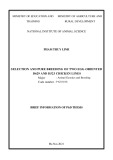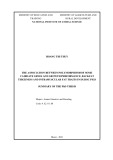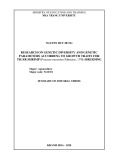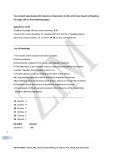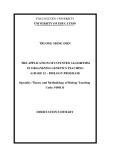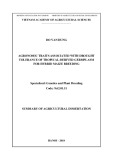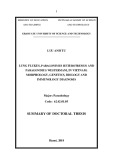Analysis of the sugar-binding specificity of mannose-binding-type Jacalin-related lectins by frontal affinity chromatography – an approach to functional classification Sachiko Nakamura-Tsuruta1, Noboru Uchiyama1, Willy J. Peumans2, Els J. M. Van Damme2, Kiichiro Totani3, Yukishige Ito3 and Jun Hirabayashi1
1 Lectin Application and Analysis Team, Research Center for Medical Glycoscience, National Institute of Advanced Industrial Science and
Technology, Tsukuba, Japan
2 Department of Molecular Biotechnology, Ghent University, Belgium 3 RIKEN (Institute of Physical and Chemical Research), Saitama, Japan
Keywords frontal affinity chromatography; high- mannose-type glycans; Jacalin-related lectin; molecular evolution; sugar-binding specificity
Correspondence J. Hirabayashi, Lectin Application and Analysis Team, Research Center for Medical Glycoscience, National Institute of Advanced Industrial Science and Technology, AIST Tsukuba Central 2, 1-1-1, Umezono, Tsukuba, Ibaraki 305-8568, Japan Fax: +81 29 861 3125 Tel: +81 29 861 3124 E-mail: jun-hirabayashi@aist.go.jp
(Received 17 October 2007, revised 21 December 2007, accepted 9 January 2008)
doi:10.1111/j.1742-4658.2008.06282.x
The Jacalin-related lectin (JRL) family comprises galactose-binding-type (gJRLs) and mannose-binding-type (mJRLs) lectins. Although the docu- mented occurrence of gJRLs is confined to the family Moraceae, mJRLs are widespread in the plant kingdom. A detailed comparison of sugar-bind- ing specificity was made by frontal affinity chromatography to corroborate the structure–function relationships of the extended mJRL subfamily. Eight mJRLs covering a broad taxonomic range were used: Artocarpin from Artocarpus integrifolia (jackfruit, Moraceae), BanLec from Musa acuminata (banana, Musaceae), Calsepa from Calystegia sepium (hedge bindweed, Convolvulaceae), CCA from Castanea crenata (Japanese chestnut, Faga- ceae), Conarva from Convolvulus arvensis (bindweed, Convolvulaceae), CRLL from Cycas revoluta (King Sago palm tree, Cycadaceae), Heltuba from Helianthus tuberosus (Jerusalem artichoke, Asteraceae) and Morni- gaM from Morus nigra (black mulberry, Moraceae). The result using 103 pyridylaminated glycans clearly divided the mJRLs into two major groups, each of which was further divided into two subgroups based on the prefer- ence for high-mannose-type N-glycans. This criterion also applied to the binding preference for complex-type N-glycans. Notably, the result of cluster analysis of the amino acid sequences clearly corresponded to the above specificity classification. Thus, marked correlation between the sugar-binding specificity of mJRLs and their phylogeny should shed light on the functional significance of JRLs.
The Jacalin-related lectin (JRL) family is one of the seven plant lectin families categorized by Van Damme et al. [1]. As members belonging to the family show
obvious differences in their basic molecular structure, sugar-binding specificities and subcellular location, classified into two subgroups: they
further
are
Abbreviations Artocarpin, Artocarpus integrifolia agglutinin; BanLec, Musa acuminata (banana) lectin; Calsepa, Calystegia sepium agglutinin; CCA, Castanea crenata agglutinin; Conarva, Convolvulus arvensis agglutinin; CRLL, Cycas revoluta leaf lectin; FAC, frontal affinity chromatography; gJRLs, galactose-binding-type Jacalin-related lectins; Heltuba, Helianthus tuberosus agglutinin; Jacalin, galactose-binding Artocarpus integrifolia lectin; JRLs, Jacalin-related lectins; M2M2M3Mb, Mana1–2Mana1–2Mana1–3Manb; M2M3M6Mb, Mana1–2Mana1–3Mana1–6Manb; M3GN2, Man3GlcNAc2; mJRLs, mannose-binding-type Jacalin-related lectins; MornigaG, galactose-binding Morus nigra agglutinin; MornigaM, mannose-binding Morus nigra agglutinin; MPA, Maclura pomifera agglutinin; MTX, methotrexate; PA, pyridylaminated; PAL, Phlebodium aureum lectin; pNP, p-nitrophenyl; PPL, Parkia platycephala lectin.
FEBS Journal 275 (2008) 1227–1239 ª 2008 The Authors Journal compilation ª 2008 FEBS
1227
S. Nakamura-Tsuruta et al.
Oligosaccharide specificities of mJRLs
galactose-binding-type (gJRLs) and mannose-binding- type (mJRLs) Jacalin-related lectins. Although these two subgroups share sequence similarity, their molecu- lar constitutions are distinct. The former consist of a short b-chain (2 kDa) and a long a-chain (13 kDa) as a result of complex co- and post-translational process- ing, whereas the latter consist of uncleaved protomers that undergo no or only minor post-translational mod- ification [1]. This differential processing is apparently inherent to the eventual location of gJRLs and mJRLs in the vacuolar and cytoplasmic ⁄ nucleoplasmic cell compartments, respectively, and, just as importantly, forms the basis of the differences in their specificity.
residues required for binding are mainly located on the loops b1–b2 and b11–b12, and are highly conserved within the whole lectin family (or subfamilies), whereas other loop regions around them are much more diver- gent. Therefore, their detailed specificities for complex glycans are expected to reflect more clearly the charac- teristic features of individual mJRLs. Hitherto, no sys- tematic studies have been undertaken to elucidate the oligosaccharide specificity of mJRLs, except a frontal affinity chromatography (FAC) analysis of the fine specificities of two tandem-repeat-type mJRLs, namely CCA and CRLL [33]. As the latter experiments dem- onstrated that these two lectins exhibit marked differ- ences in specificity towards N-linked glycans, it seems probable that the carbohydrate-binding specificities of mJRLs are much more divergent than is currently believed. Therefore, to understand the structure–func- tion relationship from a more systematic and evolu- tionary viewpoint, six additional mJRLs isolated from species covering a wide taxonomic range were analyzed (Artocarpin, BanLec, Calsepa, Conarva, Heltuba and MornigaM), and a detailed quantitative comparison of the specificity data was made. This approach revealed both conserved and divergent features of mJRL speci- ficities, which sheds new light on the biological aspects of mJRLs, as well as on their use as fine tools.
(e.g. BanLec
from Musa
Results
Evaluation of the effective ligand content of the lectin columns
arvensis
The documented occurrence of gJRLs, represented by Jacalin from Artocarpus integrifolia (jackfruit), is, to date, confined to the family Moraceae: for example, MPA from Maclura pomifera (osage orange) [2] and MornigaG from Morus nigra (black mulberry) [3]. They are extensively used as tools to detect mucin-type such as GalNAc-a, Core 1 (T-antigen, O-glycans, Galb1–3GalNAca) (GlcNAcb1–3Gal- and Core 3 NAca) disaccharides [4–8]. In contrast, mJRLs have a much wider taxonomic distribution, having been iso- lated from a fern (Phlebodium aureum lectin, PAL) [9], a cycad (Cycas revoluta leaf lectin, CRLL) [10] and including both Liliopsida numerous angiosperms, acuminata (monocots) (banana, Musaceae) [11–15]) and dicots (e.g. Artocar- pin from A. integrifolia (jackfruit, Moraceae) [16–18], Calsepa from Calystegia sepium (hedge bindweed, Convolvulaceae) [19,20], CCA from Castanea crenata (Japanese chestnut, Fagaceae) [21], Conarva from Convolvulus (bindweed, Convolvulaceae; E. J. M. Van Damme et al., unpublished data), Hel- tuba from Helianthus tuberosus (Jerusalem artichoke, Asteraceae) [22], MornigaM from M. nigra (black mul- berry, Moraceae) [3,23,24] and PPL from Parkia platy- cephala (Mimosoideae subfamily of the Fabaceae) [25]).
(see
For FAC, six purified mJRLs (Artocarpin, BanLec, Calsepa, Conarva, Heltuba and MornigaM) were immobilized on NHS-activated Sepharose 4FF at vari- ous concentrations (Table 1). To determine the effec- (Bt), a ‘concentration-dependent tive ligand content analysis’ was carried out first. Of the six mJRLs, only MornigaM showed significant affinity for p-nitrophe- nyl (pNP)-a-Man (Mana-pNP), whereas the other five mJRLs showed no detectable affinity for any of the commercially available pNP-labeled simple saccharides. Methotrexate (MTX) derivatives of two high-mannose- type N-linked glycans, Man3GlcNAc2 (M3GN2)-MTX [34] and Man9GlcNAc2 (M9GN2)-MTX, were pre- pared and tested for affinity to the lectins. M3GN2- MTX proved to be a suitable ligand for Artocarpin, Calsepa, Conarva and Heltuba, and M9GN2-MTX for BanLec (see supplementary Fig. S1A). Concentration- dependent analysis using these MTX derivatives yielded Bt values in the range 0.18–8.96 nmol for the mJRL columns supplementary Fig. S1B–D). Regression lines (for the Woolf–Hofstee-type plots)
Substantial efforts have been made to determine in detail the biochemical properties of mJRLs, in particu- lar the protein structures and physiological features. Although all mJRLs share the basic ability to bind mannose ⁄ glucose, they clearly differ in fine specificity. Recent X-ray crystallography and modeling studies of Artocarpin [26], BanLec [27,28], Calsepa [29], Morni- gaM [23], Heltuba [30] and PPL [31] have revealed that the subunits of all of these lectins adopt essen- tially the same three-dimensional structure called a b-prism fold, which is also common to Jacalin, a repre- sentative gJRL [32]. Except for BanLec, they have one sugar-binding site per subunit, which accommodates mannose and glucose as well as their derivatives. Key
FEBS Journal 275 (2008) 1227–1239 ª 2008 The Authors Journal compilation ª 2008 FEBS
1228
S. Nakamura-Tsuruta et al.
Oligosaccharide specificities of mJRLs
lectin-immobilized columns used in this study. M3GN2-MTX and M9GN2-MTX represent methotrexate-labeled
Table 1. Features of Man3GlcNAc2 and Man9GlcNAc2, respectively.
Lectin name
Scientific name of plant species
Sugars used for concentration-dependent analysis
r2 a
Immobilized (mgÆmL)1)
Bt (nmol)
Artocarpin
Artocarpus integrifolia
BanLec
Musa acuminata
Calsepa
Calystegia sepium
Conarva Heltuba MornigaM
Convolvulus arvensis Helianthus tuberosus Morus nigra
0.1 0.5 0.5 0.05 0.1 0.3 0.5 4.6 9.0
0.24 0.52b 0.18 2.68b 0.20 1.46 1.05 2.10 8.96
0.97 – 0.94 – 0.99 0.99 0.99 1.00 0.98
M3GN2-MTX – M9GN2-MTX – M3GN2-MTX M3GN2-MTX M3GN2-MTX M3GN2-MTX Mana-pNP
a Reliability of lines obtained from a Woolf–Hofstee-type plot in each concentration-dependent analysis. b Bt values were calculated from those determined by concentration-dependent analysis with alternative columns.
Functional classification of the eight mJRLs into two groups
with r2 values of more than 0.94 (average, 0.98) were obtained. The specifications of the columns are sum- marized in Table 1.
In the case of Artocarpin and BanLec, two columns with different protein concentrations were used to cover a broad range of affinity strength (Table 1). For these lectins, Bt values were determined experimentally for one of the columns, whereas, for the other, they were calculated from the ratio of V – V0 values obtained for several appropriate reference glycans.
Overall interaction features of the eight mJRLs
Although some mJRLs displayed similar sugar-binding specificities, FAC analyses revealed that others exhib- ited quite distinct carbohydrate-binding properties (Fig. 1). To corroborate the apparent intra-subfamily relationship, Ka values of high-mannose-type N-linked glycans (001–014) were expressed in terms of relative affinity (%) to the best ligand for each lectin. Thereby, it became evident that the eight mJRLs studied can be subdivided into two groups: group A, including Con- arva, Calsepa, MornigaM, CCA and Artocarpin, and group B, comprising Heltuba, CRLL and BanLec (Fig. 2). Group A apparently preferred relatively small high-mannose-type glycans (Man2–Man6, 001–007) to larger ones (Man7–Man9, 008–014), whereas group B preferred the latter. To examine whether this criterion applied to other types of glycans, the approach was extended to a much wider range of glycans, i.e. com- plex-type glycans consisting of mono-, bi- and tri- antennary glycans, and those with a bisecting GlcNAc. As shown in Fig. 3, the subdivision in groups A and B can be extended to the binding specificity to complex- type glycans. The details of the characteristic features of the two groups and their fine specificities are described below.
Fine specificities of group A mJRLs
Detailed carbohydrate-binding specificities of the six mJRLs, i.e. Artocarpin, BanLec, Calsepa, Conarva, Heltuba and MornigaM, were analyzed by FAC using 103 pyridylaminated (PA) oligosaccharides (2.5 or 5.0 nm). Using the observed V – V0 values, Kd values were calculated according to Eqn (2) in a manner inde- pendent of [A]0 (see FAC procedure section). The Ka (= 1 ⁄ Kd) values obtained are summarized in supple- mentary Table S1, together with those reported previ- ously for CCA and CRLL [33]. Significant affinities for N-linked glycans were observed for all eight mJRLs (001–506), whereas no affinity was detected for glycolipid-type glycans (701–739) and others (901– 911). For comparative purposes, a bar graph represen- tation of the binding data of the N-linked glycans (001–506) was made (Fig. 1). As all eight mJRLs rec- ognized the smallest glycan 002, the prerequisite for their recognition of N-linked glycans is considered to be Mana1–3Manb in the core mannotriose (Fig. 1 and supplementary Table S1; see also supplementary text for a description of the detailed sugar-binding specifici- ties of each mJRL).
Group A comprises Conarva, Calsepa, MornigaM, CCA and Artocarpin, all of which are found in dicoty- ledonous plants. They share an apparent preference for smaller (Man2–Man6, 001–007) high-mannose-type glycans to larger ones (Man7–Man9, 008–014) (Fig. 3).
FEBS Journal 275 (2008) 1227–1239 ª 2008 The Authors Journal compilation ª 2008 FEBS
1229
S. Nakamura-Tsuruta et al.
Oligosaccharide specificities of mJRLs
Fig. 1. Bar graph representation of the affinity constants (Ka) of eight mJRLs for N-linked glycans. The numbers at the bottom of each panel correspond to those indicated in Fig. 7A. I, II, III and IV at the top of the graphs refer to high-mannose-type, agalactosylated, galactosylated and sialylated N-linked glycans, respectively.
results
006), whereas b1–2GlcNAc was tolerated to some degree. Indeed, a decreased but still significant affinity was observed for bi-antennary glycans (103, 202, 307 and 405), except for Artocarpin (Fig. 3). Generally, tri- and tetra-antennary glycans were not ligands for group A mJRLs (Fig. 3, supplementary Table S1).
a distinguishing
Within group A,
FAC analysis revealed that the poor reactivity towards the larger high-mannose-type glycans from severe detrimental effects of a1–2Man in the Mana1– 2Mana1–3Manb (M2M3Mb) branch (for the nomen- clature of branches, see Materials and methods and Fig. 7B), as demonstrated by a comparison between 005 and 006 (Fig. 3, supplementary Table S1). Another common feature was that all group A members recog- nized both a1–6 extended (101, 201, 301 and 401) and a1–3 extended (102, 302 and 402) mono-antennary glycans (Fig. 3). The addition of a1–2Man to the Mana1–3Manb branch resulted in a considerable loss of affinity, as mentioned above (compare 005 with
feature was observed for Calsepa and Conarva, which exhibited a dramatically increased affinity for complex-type N-gly- cans having bisecting GlcNAc (Fig. 3). For example, the affinity of Calsepa and Conarva was 4.8 and 4.6 times higher, respectively, for 308 than for 307 (supple- mentary Table S1). As the ability to recognize bisecting
FEBS Journal 275 (2008) 1227–1239 ª 2008 The Authors Journal compilation ª 2008 FEBS
1230
S. Nakamura-Tsuruta et al.
Oligosaccharide specificities of mJRLs
trates the crucial importance of a1–2Man (150 times enhanced) (supplementary Table S1).
unmodified) mono-antennary
Fig. 2. Relative affinity (%) of high-mannose-type glycans com- pared with the best ligands for each lectin. The numbers on the left correspond to the numbers of the sugars ⁄ glycans listed in Fig. 7A. The eight mJRLs are divided into two groups (group A and B) on the basis of their specificities towards high-mannose-type glycans. Group A prefers smaller high-mannose-type glycans (Man2–Man6) to larger ones (Man7–Man9) (contained within square bounded by full line); group B prefers larger high-mannose-type glycans to smal- ler ones (contained within square bounded by broken line).
In spite of the difference in affinity for high-manno- se-type glycans, Heltuba and CRLL showed a con- served absolute preference for a1–6 extended (i.e. a1– 3Man complex-type glycans (101, 201, 301 and 401) (Fig. 3). Thus, neither a1–3 extended, mono-antennary glycans (102, 302 and 402) nor bi-, tri- and tetra-antennary glycans were rec- ognized (Fig. 3). The difference is clearly a result of the differential effect of the addition of b1–2GlcNAc to a1–3Man, i.e. group A mJRLs tolerate this extension to variable extents, whereas Heltuba and CRLL do not. In contrast with Heltuba and CRLL, BanLec did not show any affinity for complex type N-glycans, although trace binding was detected for a1–6 branched, mono-antennary glycans (101, 201, 301 and 401; sup- plementary Table S1). Considering the fact that the structural unit preferred by BanLec (M2M6M6Mb) occurs in yeast mannan, and that the lectin shows no affinity for complex-type glycans, physiologically rele- vant internal or external mannooligosaccharides syn- thesized by fungi might act as ligands of BanLec, as suggested previously [13]. Judging from the prejudiced affinity of BanLec to selected members of high-man- nose-type glycans, group B mJRLs can be divided fur- ther into two subgroups: subgroup B-1 (Heltuba and CRLL) and subgroup B-2 (BanLec) (Fig. 4).
Discussion
GlcNAc is confined to Calsepa and Conarva (Con- volvulaceae), this particular binding feature most prob- ably evolved after divergence of the Convolvulaceae lectins from the other members of group A. Accord- ingly, group A can be further subdivided into two i.e. mJRLs belonging to Con- subgroups (Fig. 4), volvulaceae (subgroup A-2) and those belonging to other dicot plants (subgroup A-1).
Fine specificities of group B mJRLs
(Fig. 4). All
the members
in
a1–2Man
recognized
and 014)
(Fig. 3,
(013
Group B comprises Heltuba, CRLL and BanLec, all of which exhibit an apparent preference for larger (Man7–Man9) rather than smaller (Man2–Man6) high- mannose-type glycans. However, their fine specificities were significantly different from each other (Fig. 3). Heltuba the terminal M2M3Mb branch (006, 008, 010 and 011), whereas CRLL recognized (as previously reported [33]), with a much higher affinity, terminal a1–2Man residues located on both M2M3M6Mb and M2M2M3Mb branches supplementary Table S1). BanLec only reacted with some larger high- mannose-type glycans, namely 008, 011, 012 and 014 (Figs 1 and 3), all of which have the M2M6M6Mb branch. It is therefore presumed that a1–2Man in the M2M6M6Mb branch contributes significantly to the specific affinity of BanLec binding. A comparison of the binding of BanLec to 006 and 008 clearly illus-
Comprehensive and systematic analysis of the sugar- binding specificities of the eight mJRLs revealed both conserved and divergent aspects of their sugar-binding properties. Based on our results, the eight mJRLs can be classified into two major groups, each further com- posed of two subgroups (i.e. subgroups A-1, A-2, B-1 included in and B-2) group A are derived from dicot plants, with subgroup A-2 specifically composed of two lectins from the fam- ily Convolvulaceae. By contrast, group B includes three taxonomically unrelated members, i.e. Heltuba from a dicot plant, BanLec from a monocot plant [both in the phylum Magnoliophyta (angiosperms)] and CRLL from the phylum Cycadophyta. In this context, the classification based on FAC results does not completely agree with the taxonomic classification. Hitherto, the relationships between the different mem- bers of mJRL have been exclusively discussed in terms of amino acid sequence similarity [35]. No attempts have been made to trace possible functional relation- ships based on a systematic comparison of sugar-bind- ing specificities.
FEBS Journal 275 (2008) 1227–1239 ª 2008 The Authors Journal compilation ª 2008 FEBS
1231
S. Nakamura-Tsuruta et al.
Oligosaccharide specificities of mJRLs
Fig. 3. Bar graph representation of the relative affinity (%) of the eight mJRLs towards selected N-linked glycans. The numbers on the left correspond to the numbers of the sugars ⁄ glycans listed in Fig. 7A.
To corroborate whether a possible relationship exists between the sugar-binding specificities and primary structure, a correlation analysis was performed of sequences of the respective mJRLs using the online clustalw program (http://align.genome.jp/) (Fig. 5, left). As CCA and CRLL consist of two tandemly arrayed lectin domains, the amino acid sequences of the individual N-terminal and C-terminal carbohydrate recognition domains were used for the analysis. As shown in Fig. 5, the dendrogram indicates a clear cor- relation between sequence similarities and the carbohy- drate specificity profiles obtained by FAC (Fig. 5,
right). First, members of group A (MornigaM, Arto- carpin, CCA, Calsepa and Conarva) form a separate cluster well distant from the lectins of group B (Heltuba, CRLL and BanLec). Moreover, the relation- ships of the subgroups are in good agreement with the sequence similarities (Figs 4 and 5), which indicates that the carbohydrate-binding specificity of the mJRLs evolved together with their primary structure during the course of molecular evolution. A closer observa- tion of the data suggests that the specificity of the mJRLs gradually shifted from a recognition of high- mannose-specific to more complex-type N-glycans, i.e.
FEBS Journal 275 (2008) 1227–1239 ª 2008 The Authors Journal compilation ª 2008 FEBS
1232
S. Nakamura-Tsuruta et al.
Oligosaccharide specificities of mJRLs
Fig. 4. Overview of the sugar-binding speci- ficities of mJRLs. The mJRLs were divided into two groups on the basis of their specific- ity towards high-mannose-type glycans (groups A and B). Each group was further subdivided into two subgroups on the basis of the detailed specificities towards complex- type glycans. For group A, the affinities of MornigaM, Artocarpin and CCA were reduced by a bisecting GlcNAc (subgroup A-1), whereas those of Calsepa and Conarva were enhanced (subgroup A-2). In the case of group B, Heltuba and CRLL reacted well with mono-antennary glycans (subgroup B-1), whereas BanLec did not (subgroup B-2).
Fig. 5. Correlation between sugar-binding specificity and phylogeny of the mJRLs. Phylogenetic relationships are represented in the dendrogram shown on the left-hand side and the corresponding specificities are given in the bar graph representation of the relative affinity of the lectins shown on the right. The amino acid sequences used to construct the dendrogram were from the following accession numbers: AAM48480 (BanLec), AAD11575 (Heltuba), BAE95375 (CRLL), AAL10685 (MornigaM), 1VBO (Arto- carpin), P82859 (CCA), AAC49564 (Calsepa) and AAG10403 (Conarva). Right: vertical axis indicates the relative affinity (%) compared with the best ligand of each lectin. The group name corresponds to Fig. 4. Numbers at the bottom correspond to the numbers of the sugars ⁄ glycans listed in Fig. 7A. I, smal- ler high-mannose-type glycans (Man2– Man6); II, larger high-mannose-type glycans (Man7–Man9); III, mono-antennary N-linked glycans; IV, bi-antennary N-linked glycans; V, tri-antennary N-linked glycans; VI, N-linked glycans with bisecting GlcNAc.
from B-2 to B-1, and further to A-1 and A-2. How- ever, it is evident that the specificity of all mJRLs is still directed against N-glycans. The conversion of mJRLs into gJRLs, which display a fundamentally is clearly directed against different specificity that
mucin-type O-glycans [8], relies on a totally different evolutionary event, whereby an ancestral mJRL domain was fused to a signal peptide and N-terminal propeptide [3]. In other words, molecular evolution within the subfamily mJRL was gradual, whereas that
FEBS Journal 275 (2008) 1227–1239 ª 2008 The Authors Journal compilation ª 2008 FEBS
1233
S. Nakamura-Tsuruta et al.
Oligosaccharide specificities of mJRLs
between the two subfamilies mJRL and gJRL occurred rather intermittently.
According to the sugar-binding specificities, Heltuba (from a dicot plant) is classified in the same group (group B) as the phylogenetically more distant mJRLs BanLec (monocot) and CRLL (cycad). Thus, the molecular evolution of the mJRLs does not necessarily correlate with the established taxonomy of the plant species. In this context, our data demonstrate that information on the sugar-binding specificities of mJRLs is more precisely reflected by their amino acid sequences than their biological phylogeny.
Recent X-ray crystallography and modeling studies have revealed that mJRLs have one combined sugar- binding site per subunit, except for BanLec [23,26–31]. Key residues required for binding are especially located on the GG (loop b1–b2; Fig. 6) and ligand-binding (loop b11–b12; Fig. 6) loops. As shown in Fig. 6, resi- dues in the GG loop and the ligand-binding loop are highly conserved amongst the eight mJRLs. By con- trast, residues in the ligand recognition loop (loop b7– b8; Fig. 6) are highly divergent. The three mJRLs belonging to subgroups B-1 (BanLec) and B-2 (Heltuba and CRLL) have a relatively short ligand
Fig. 6. Sequence alignment of the eight mJRLs. As CCA and CRLL consist of two tandemly arrayed lectin domains, the amino acid sequences of the individual N-terminal and C-terminal carbohydrate recognition domains were aligned separately. GG loop, loops b1–b2; ligand recognition loop, loops b7–b8; ligand-binding loop, loops b11–b12.
FEBS Journal 275 (2008) 1227–1239 ª 2008 The Authors Journal compilation ª 2008 FEBS
1234
S. Nakamura-Tsuruta et al.
Oligosaccharide specificities of mJRLs
ture–function relationships of, not only JRLs, but also many other carbohydrate-binding proteins.
Materials and methods
Materials
NHS-activated Sepharose was purchased from Amersham Pharmacia Biotech (Little Chalfont, Buckinghamshire, UK). All chemical reagents used were of analytical grade. All pNP glycosides were obtained from commercial sources; Gala, Galb, GalNAca, Galb1–3GalNAca, Manb and
recognition loop, compared with members in subgroup A-1 (MornigaM, Artocarpin and CCA). This shorter loop should form a larger cavity in the sugar-binding site, and therefore result in high affinity of group B mJRLs for larger high-mannose-type glycans. Such short loops are also observed in subgroup A-2 (Calsep- a and Conarva). This feature may promote binding to N-glycans, including bisecting GlcNAc, although no supporting data are available currently from a struc- tural biological viewpoint. Nevertheless, the present approach is essential in establishing a fundamental understanding of the molecular evolution and struc-
A
B
(a-linked mannose) and ‘Mb’
Fig. 7. (A) Schematic representation of the structure of pyridylaminated N-linked glycans. Note that the reducing terminal is pyridylaminated for FAC analysis. Symbols are used to represent the pyranose rings of monosaccharides (see boxed insert). The anomeric carbon, i.e. posi- tion 1, is placed at the right side, and 2, 3, 4,. . . are placed clockwise. Thick and thin bars represent a- and b-carbons, respectively. (B) Repre- sentation of branches in high-mannose-type glycans. Mannose residues are expressed as ‘M’ [b (core) mannose]. The linkage positions are numbered.
FEBS Journal 275 (2008) 1227–1239 ª 2008 The Authors Journal compilation ª 2008 FEBS
1235
S. Nakamura-Tsuruta et al.
Oligosaccharide specificities of mJRLs
Galb1–4GlcNAcb were purchased from Sigma (St Louis, MO, USA), and Glca was obtained from Calbiochem (San Diego, CA, USA). Others (GalNAcb-, Galb1–4Glcb-, Mana-, Fuca-, Glca1–4Glca- and (Glca1–4)5a-pNP) were obtained from Funakoshi Co. (Tokyo, Japan).
coupled to NHS-activated Sepharose according to the manu- facturer’s instructions. After deactivation of excess NHS groups by 1 m monoethanolamine, pH 8.3, containing 0.5 m NaCl, followed by extensive washing with coupling buffer, the lectin-Sepharose was suspended in 10 mm Tris ⁄ HCl buffer, pH 7.4. The slurry was packed into a capsule-type miniature column (inner diameter, 2 mm; length, 10 mm; bed volume, 31.4 lL). The amount of immobilized protein was determined by measuring the amount of uncoupled protein in the above wash fraction by the method of Bradford [38].
FAC procedure
The PA oligosaccharides used are listed in Fig. 7A. The PA glycans numbered 001–014, 103, 105, 107, 108, 307, 313, 314, 323, 405, 410, 418, 419, 420, 501–504 and 406 were pur- chased from Takara Bio Inc. (Kyoto, Japan). The other N-linked glycans were obtained from Seikagaku Co. (Tokyo, Japan). PA glycolipid-type glycans and others (701–911) are listed in supplementary Fig. S2. PA glycans numbered 701– 703, 705–713, 715–721, 724, 726 and 728–731 were obtained from Takara Bio Inc. The sources of non-labeled glycans were as follows: 727 from Funakoshi Co.; 733, 734 and 908 from Dextra Laboratories, Ltd. (Reading, UK); 725, 909 and 910 from Calbiochem; 906 and 907 from Seikagaku Co. Oligo-lactosamines 901, 902, 903 and 905 and milk oligosac- charides 722, 723, 732 and 735–739 were generous gifts from Kei-ichi Yoshida (Seikagaku Co.) and Tadasu Urashima (Obihiro University of Agriculture and Veterinary Medicine, Japan), respectively. The non-labeled glycans were used after pyridylamination with GlycoTag (Takara Bio).
Representation of branches in high-mannose-type glycans
The principle of FAC has been described previously [39]. Briefly, when an excess volume of diluted fluorescently labeled glycan is continuously applied to a lectin-immobi- lized column, glycans having no affinity will pass unretarded through the column, whereas the elution front (V) of gly- cans having some affinity will be retarded as a function of the affinity strength. The retardation of the elution front rel- ative to that of an appropriate standard glycan, i.e. V – V0, was determined essentially as described by Arata et al. [40]. According to the basic equation of FAC, Eqn (1), Kd values were obtained from V – V0, where Bt is the effective ligand content (expressed in moles) and [A]0 is the initial concen- tration of glycan. When [A]0 is negligibly small (< 10)8 m) compared with Kd (> 10)6 m), Eqn (1) can be simplified to Eqn (2). Thus, V – V0 is inversely proportional to Kd.
ð1Þ Kd ¼ Bt=ðV (cid:2) V0Þ (cid:2) ½A(cid:3)0
if
ð2Þ
Kd ¼ Bt=ðV (cid:2) V0Þ;
Kd (cid:4) ½A(cid:3)0
In this study, mannose residues in high-mannose-type gly- cans are indicated as either ‘M’ (a-linked mannose) or ‘Mb’ [b (core) mannose]. The positions of the linkages are indi- cated by Arabic numbers (Fig. 7B). For example, a branch included in 005 (Mana1–6Mana1–6Manb) is represented by M6M6Mb, and the extended branch in 009 (Mana1– 2Mana1–2Mana1–3Manb) is represented by M2M2M3Mb.
Synthesis of MTX-labeled glycans
MTX-labeled Man3GlcNAc2 was synthesized as described previously [33,34]. The synthesis of MTX-labeled Man9Glc- NAc2 was conducted as reported previously [36].
Purification of lectins
Frontal affinity chromatography was performed using an automated machine, FAC-1 [33,41]. Each lectin column was slotted into a stainless holder, connected to the FAC-1 machine, and equilibrated with 10 mm Tris ⁄ HCl buffer, pH 7.4, containing 0.8% NaCl (TBS). The flow rate and column temperature were kept at 0.125 mLÆmin)1 and 25 (cid:2)C, respectively. After equilibration of the miniature col- umns, either PA (2.5 nm for N-linked glycans and 5.0 nm for others) or pNP (5.0 lm) oligosaccharides, dissolved in TBS, were successively injected into the lectin columns by the autosampling system. The elution of PA oligosaccha- rides was monitored by fluorescence (excitation and emis- sion wavelengths of 310 and 380 nm, respectively), and the elution of pNP glycosides was recorded by a UV monitor (280 nm). A representative chromatogram is shown in sup- plementary Fig. S3. Lectins were isolated as described previously. Artocarpin was prepared from jackfruit seeds [37], MornigaM from black mulberry bark [3], BanLec from banana fruit [12], Calsepa and Conarva from rhizomes of Calystegia sepium and Convolvulus arvensis, respectively [19], and Heltuba from Jerusalem artichoke tubers [22].
Preparation of lectin columns
Evaluation of the effective ligand content of lectin columns
FEBS Journal 275 (2008) 1227–1239 ª 2008 The Authors Journal compilation ª 2008 FEBS
1236
For the determination of the effective ligand content Bt, concentration-dependent analysis and subsequent Woolf– Purified lectins were dissolved in coupling buffer (0.2 m NaHCO3 buffer, pH 8.3, containing 0.5 m NaCl) and
S. Nakamura-Tsuruta et al.
Oligosaccharide specificities of mJRLs
analysis by frontal affinity chromatography. Glyco- biology 16, 46–53. 9 Tateno H, Winter HC, Petryniak J & Goldstein IJ
plots, i.e. (V – V0)
(2003) Purification, characterization, molecular cloning, and expression of novel members of jacalin-related lec- tins from rhizomes of the true fern Phlebodium aureum (L.) J. Smith (Polypodiaceae). J Biol Chem 278, 10891– 10899. Hofstee-type plots were performed as described previously [39]. Various concentrations ([A]0, 1–50 lm) of Mana-pNP and MTX-derivatized Man3GlcNAc2 or Man9GlcNAc2 dissolved in TBS were applied to the miniature column, and the elution was monitored by the absorbance at vs. 304 nm. Woolf–Hofstee-type (V – V0)[A]0, were performed to determine the Bt and Kd values from the intercept and slope, respectively, of the fitted curves. 10 Yagi F, Iwaya T, Haraguchi T & Goldstein IJ
Acknowledgement
(2002) The lectin from leaves of Japanese cycad, Cycas revoluta Thunb. (gymnosperm), is a member of the jacalin-related family. Eur J Biochem 269, 4335–4341. 11 Koshte VL, van Dijk W, van der Stelt ME & Aalberse
This work was supported by the New Energy and Industrial Technology Development Organization (NEDO) under the Ministry of Economy, Trade, and Industry of Japan (METI).
RC (1990) Isolation and characterization of BanLec-I, a mannoside-binding lectin from Musa paradisiac (banana). Biochem J 272, 721–726.
References
1 Van Damme EJM, Peumans WJ, Barre A & Rouge P 12 Peumans WJ, Zhang W, Barre A, Houles CH, Astoul C, Balint-Kurti PJ, Rovira P, Rouge P, May GD, Van Leuven F et al. (2000) Fruit-specific lectins from banana and plantain. Planta 211, 546–554. 13 Mo H, Winter HC, Van Damme EJM, Peumans WJ,
(1998) Plant lectins: a composite of several distinct fam- ilies of structurally and evolutionary related proteins with diverse biological roles. Crit Rev Plant Sci 17, 575–692. 2 Young NM, Johnston RA & Watson DC (1991) The Misaki A & Goldstein IJ (2001) Carbohydrate binding properties of banana (Musa acuminata) lectin I. Novel recognition of internal alpha1,3-linked glucosyl residues. Eur J Biochem 268, 2609–2615. 14 Goldstein IJ, Winter HC, Mo H, Misaki A, Van amino acid sequences of jacalin and the Maclura pomif- era agglutinin. FEBS Lett 282, 382–384.
Damme EJM & Peumans WJ (2001) Carbohydrate binding properties of banana (Musa acuminata) lectin II. Binding of laminaribiose oligosaccharides and beta- glucans containing beta1,6-glucosyl end groups. Eur J Biochem 268, 2616–2619. 3 Van Damme EJM, Hause B, Hu J, Barre A, Rouge P, Proost P & Peumans WJ (2002) Two distinct jacalin- related lectins with a different specificity and subcellular location are major vegetative storage proteins in the bark of the black mulberry tree. Plant Physiol 130, 757–769.
4 Wu AM, Wu JH, Lin LH, Lin SH & Liu JH (2003) Binding profile of Artocarpus integrifolia agglutinin (Jacalin). Life Sci 72, 2285–2302. 5 Gupta D, Rao NV, Puri KD, Matta KL & Surolia A 15 Winter HC, Oscarson S, Slattegard R, Tian M & Gold- stein IJ (2005) Banana lectin is unique in its recognition of the reducing unit of 3-O-beta-glucosyl ⁄ mannosyl disaccharides: a calorimetric study. Glycobiology 15, 1043–1050.
(1992) Thermodynamic and kinetic studies on the mech- anism of binding of methylumbelliferyl glycosides to jacalin. J Biol Chem 267, 8909–8918.
16 Misquith S, Rani PG & Surolia A (1994) Carbohydrate binding specificity of the B-cell maturation mitogen from Artocarpus integrifolia seeds. J Biol Chem 269, 30393–30401.
6 Sastry MV, Banarjee P, Patanjali SR, Swamy MJ, Swarnalatha GV & Surolia A (1986) Analysis of saccharide binding to Artocarpus integrifolia lectin reveals specific recognition of T-antigen (beta-d-Gal(1–3)d-GalNAc). J Biol Chem 261, 11726–11733. 7 Young NM, Johnston RA, Szabo AG & Watson DC 17 Rani PG, Bachhawat K, Misquith S & Surolia A (1999) Thermodynamic studies of saccharide binding to arto- carpin, a B-cell mitogen, reveals the extended nature of its interaction with mannotriose [3,6-di-O-(alpha-d- mannopyranosyl)-d-mannose]. J Biol Chem 274, 29694– 29698. 18 Rani PG, Bachhawat K, Reddy GB, Oscarson S &
(1989) Homology of the d-galactose-specific lectins from Artocarpus integrifolia and Maclura pomifera and the role of an unusual small polypeptide subunit. Arch Biochem Biophys 270, 596–603. 8 Tachibana K, Nakamura S, Wang H, Iwasaki H,
FEBS Journal 275 (2008) 1227–1239 ª 2008 The Authors Journal compilation ª 2008 FEBS
1237
Surolia A (2000) Isothermal titration calorimetric stud- ies on the binding of deoxytrimannoside derivatives with artocarpin: implications for a deep-seated combin- ing site in lectins. Biochemistry 39, 10755–10760. 19 Peumans WJ, Winter HC, Bemer V, Van Leuven F, Goldstein IJ, Truffa-Bachi P & Van Damme EJM Tachibana K, Maebara K, Cheng L, Hirabayashi J & Narimatsu H (2006) Elucidation of binding specificity of Jacalin toward O-glycosylated peptides: quantitative
S. Nakamura-Tsuruta et al.
Oligosaccharide specificities of mJRLs
lectin reveals a novel quaternary arrangement of a wide- spread domain. J Mol Biol 353, 574–583. (1997) Isolation of a novel plant lectin with an unusual specificity from Calystegia sepium. Glycoconj J 14, 259– 265. 20 Van Damme EJM, Barre A, Verhaert P, Rouge P &
32 Sankaranarayanan R, Sekar K, Banerjee R, Sharma V, Surolia A & Vijayan M (1996) A novel mode of carbohydrate recognition in jacalin, a Moraceae plant lectin with a beta-prism fold. Nat Struct Biol 3, 596– 603. Peumans WJ (1996) Molecular cloning of the mitogenic mannose ⁄ maltose-specific rhizome lectin from Calyste- gia sepium. FEBS Lett 397, 352–356. 21 Nomura K, Nakamura S, Fujitake M & Nakanishi T
(2000) Complete amino acid sequence of Japanese chest- nut agglutinin. Biochem Biophys Res Commun 16, 23–28.
33 Nakamura S, Yagi F, Totani K, Ito Y & Hirabayashi J (2005) Comparative analysis of carbohydrate-binding properties of two tandem repeat-type Jacalin-related lec- tins, Castanea crenata agglutinin and Cycas revoluta leaf lectin. FEBS J 272, 2784–2799. 34 Totani K, Matsuo I & Ito Y (2004) Tight binding 22 Van Damme EJM, Barre A, Mazard AM, Verhaert P, Horman A, Debray H, Rouge P & Peumans WJ (1999) Characterization and molecular cloning of the lectin from Helianthus tuberosus. Eur J Biochem 259, 135–142. 23 Rouge P, Peumans WJ, Barre A & Van Damme EJM ligand approach to oligosaccharide-grafted protein. Bioorg Med Chem Lett 14, 2285–2289.
35 Raval S, Gowda SB, Singh DD & Chandra NR (2004) A database analysis of jacalin-like lectins: sequence- structure–function relationships. Glycobiology 14, 1247– 1263. (2003) A structural basis for the difference in specificity between the two jacalin-related lectins from mulberry (Morus nigra) bark. Biochem Biophys Res Commun 304, 91–97.
36 Totani K, Matsuo I & Ito Y (2006) High-mannose-type glycan modifications of dihydrofolate reductase using glycan-methotrexate conjugates. Bioorg Med Chem 14, 5220–5229. 24 Wu AM, Wu JH, Singh T, Chu KC, Peumans WJ, Rouge P & Van Damme EJ (2004) A novel lectin (Morniga M) from mulberry (Morus nigra) bark recog- nizes oligomannosyl residues in N-glycans. J Biomed Sci 11, 874–885.
37 Barre A, Peumans WJ, Rossignol M, Borderies G, Culerrier R, Van Damme EJM & Rouge´ P (2004) Artocarpin is a polyspecific jacalin-related lectin with a monosaccharide preference for mannose. Biochimie 86, 685–691.
25 Mann K, Farias CM, del Sol FG, Santos CF, Grangeiro TB, Nagano CS, Cavada BS & Calvete JJ (2001) The amino-acid sequence of the glucose ⁄ mannose-specific lectin isolated from Parkia platycephala seeds reveals three tandemly arranged jacalin-related domains. Eur J Biochem 268, 4414–4422.
38 Bradford M (1976) A rapid and sensitive method for the quantitation of microgram quantities of protein utilizing the principle of protein–dye binding. Anal Biochem 72, 248.
39 Hirabayashi J, Arata Y & Kasai K (2003) Frontal affin- ity chromatography as a tool for elucidation of sugar recognition properties of lectins. Methods Enzymol 362, 353–368. 26 Pratap JV, Jeyaprakash AA, Rani PG, Sekar K, Surolia A & Vijayan M (2002) Crystal structures of artocarpin, a Moraceae lectin with mannose specificity, and its complex with methyl-alpha-d-mannose: implications to the generation of carbohydrate specificity. J Mol Biol 317, 237–247.
40 Arata Y, Hirabayashi J & Kasai KI (2001) Application of reinforced frontal affinity chromatography and advanced processing procedure to the study of the binding property of a Caenorhabditis elegans galectin. J Chromatogr A 905, 337–343.
41 Hirabayashi J (2004) Lectin-based structural glycomics: glycoproteomics and glycan profiling. Glycoconj J 21, 35–40. 27 Meagher JL, Winter HC, Ezell P & Goldstein IJ (2005) Crystal structure of banana lectin reveals a novel sec- ond sugar binding site. Glycobiology 15, 1033–1042. 28 Singh DD, Saikrishnan K, Kumar P, Surolia A, Sekar K & Vijayan M (2005) Unusual sugar specificity of banana lectin from Musa paradisiaca and its probable evolutionary origin. Crystallographic and modelling studies. Glycobiology 15, 1025–1032. 29 Bourne Y, Roig-Zamboni V, Barre A, Peumans WJ,
Supplementary material
is available
Astoul CH, Van Damme EJM & Rouge P (2004) The crystal structure of the Calystegia sepium agglutinin reveals a novel quaternary arrangement of lectin sub- units with a beta-prism fold. J Biol Chem 279, 527–533. 30 Bourne Y, Zamboni V, Barre A, Peumans WJ, Van
Damme EJM & Rouge P (1999) Helianthus tuberosus lectin reveals a widespread scaffold for mannose-binding lectins. Structure 7, 1473–1482.
The following supplementary material online: Doc. S1. Detailed specificities of mJRLs. formulae of methotrexate Fig. S1. (A) Structural (MTX)-derivatized Man3GlcNAc2 (M3GN2-MTX) and MTX-derivatized Man9GlcNAc2 (M9GN2-MTX), which were used for concentration-dependent analysis.
FEBS Journal 275 (2008) 1227–1239 ª 2008 The Authors Journal compilation ª 2008 FEBS
1238
31 Gallego del Sol F, Nagano C, Cavada BS & Calvete JJ (2005) The first crystal structure of a Mimosoideae
S. Nakamura-Tsuruta et al.
Oligosaccharide specificities of mJRLs
full sugars were
Chromatograms obtained from positive (002, line) and negative (701, dotted line) overlain. Table S1. Ka values determined by frontal affinity chromatography for pyridylaminated oligosaccharides. This material is available as part of the online article
from http://www.blackwell-synergy.com
Please note: Blackwell Publishing are not responsible for the content or functionality of any supplementary materials supplied by the authors. Any queries (other than missing material) should be directed to the corre- sponding author for the article.
(B–D) Determination of Bt values. M3GN2-MTX, M9GN2-MTX and Mana-pNP were diluted to various concentrations (1–50 lm) and applied to each column. s, Calsepa; d, Conarva; h, Artocarpin; j, BanLec; n, MornigaM; m, Heltuba. Fig. S2. Schematic representation of pyridylaminated glycolipid-type glycans and other glycans. Symbols corresponding to each monosaccharide are shown in the boxed insert. Fig. S3. A representative chromatogram scan of fron- tal affinity chromatography. Pyridylaminated glycans were injected into an Artocarpin-immobilized column.
FEBS Journal 275 (2008) 1227–1239 ª 2008 The Authors Journal compilation ª 2008 FEBS
1239









